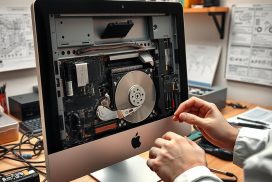How to Handle iMac Hard Drive SMART Errors
A SMART hard disk error on your iMac can be concerning, as it indicates a potential failure of the computer’s hard drive. However, it’s important to note that SMART errors can sometimes be false alarms. SMART stands for “Self Monitoring Analysis and Reporting Technology System,” and it is a mechanism used by Macs to monitor the status of the hard drive and detect any operational failures or errors. To handle SMART errors on your iMac, you can follow steps such as performing routine maintenance, clearing viruses and malware, running the Disk Utility tool, and backing up and erasing your hard disk.
Handling hard drive SMART errors on your iMac is crucial to ensuring the longevity and performance of your device. By taking proactive measures and following the recommended steps, you can effectively address SMART errors and minimize the risk of data loss or hardware failure. Let’s delve into the details of what SMART errors are and how you can troubleshoot and resolve them to keep your iMac running smoothly.
Continue reading to discover more about SMART errors and how to troubleshoot them.
What is a SMART Error?
A SMART error is an indication that your iMac’s hard drive may be experiencing damage or potential impending issues. SMART stands for “Self Monitoring Analysis and Reporting Technology System.” It is designed to detect and report failures and errors in the hard drive, serving as a warning for you to address any errors or backup your data before a potential failure occurs.
SMART errors can be caused by various factors, such as:
- Water or excessive humidity
- Electrical surge or battery failure
- Internal mechanical parts failing
- Internal or external heat damage
- Physical shock or impact
While SMART errors themselves cannot prevent damage, they provide valuable insight into the health of your hard drive. By identifying potential issues, you will have the opportunity to mitigate them before they cause significant data loss or system failure.
“A SMART error is like a canary in a coal mine- it signals potential dangers and prompts you to take necessary precautions to safeguard your data and device.”
To ensure the longevity and reliability of your iMac’s hard drive, it is essential to regularly monitor SMART status, perform routine maintenance, and backup your data.
Potential Impending Issues Caused by SMART Error
| Potential Issues | Recommended Actions |
|---|---|
| Data loss | Regularly backup your files to an external storage device or cloud service to prevent permanent data loss. |
| System failure | Address any detected issues promptly to avoid system failures that can compromise the overall functionality of your iMac. |
| Decreased performance | Take proper measures to resolve SMART errors and optimize the performance of your iMac’s hard drive. |
By understanding what a SMART error entails and taking proactive measures, you can minimize the impact of potential impending issues and ensure the safety of your data.
Troubleshooting SMART Hard Drive Errors
If you encounter a SMART error on your iMac, there are several steps you can take to troubleshoot and resolve the issue. First, it is important to perform routine maintenance on your Mac. This includes shutting down and restarting the computer, emptying the trash, closing unnecessary programs and windows, and using a tool like MacKeeper’s Safe Cleanup to clean your computer.
Next, you should check your computer for viruses and malware using an antivirus tool like MacKeeper. Viruses and malware can cause errors and affect the performance of your hard drive. By clearing these threats, you can eliminate any potential issues that may be triggering the SMART error.
Additionally, running the Disk Utility tool can help you repair any issues with the hard drive. Disk Utility is a built-in macOS tool that allows you to verify and repair disks. By running Disk Utility, you can potentially resolve any errors or issues that are causing the SMART error.
Pro Tip: In Disk Utility, select your hard drive and click on “First Aid” to perform a comprehensive scan and repair any detected errors.
Finally, it is recommended to backup and erase your hard disk. This step ensures the safety of your data and can help prevent future SMART errors. Backing up your data involves creating a copy of your important files and storing them in a separate location. Once your data is safely backed up, you can proceed with erasing your hard disk to start fresh and eliminate any underlying issues that may have led to the SMART error.
Remember, troubleshooting SMART errors on your iMac requires a systematic approach. By performing routine maintenance, clearing viruses and malware, running Disk Utility, and backing up and erasing your hard disk, you can effectively troubleshoot and resolve SMART errors on your Mac.
| Steps to Troubleshoot SMART Errors on Mac |
|---|
| Perform routine maintenance on your Mac (shutting down, emptying trash, closing unnecessary programs, etc.) |
| Check your computer for viruses and malware |
| Run the Disk Utility tool to repair any issues with the hard drive |
| Backup and erase your hard disk to ensure data safety |
How to Check SMART Status on Your Mac
After performing the necessary troubleshooting steps for SMART errors, it is important to check the SMART status on your Mac to determine if the issue has been resolved. Checking the SMART status allows you to verify the health of your hard drive and take appropriate action. Here’s how you can do it:
- Open the Disk Utility application on your Mac.
- Select the primary disk that you want to check.
- Click on the “First Aid” tab.
- Click on the “Verify Disk” button to initiate the SMART status check.
If the SMART status reads “Verified,” congratulations! Your hard drive is in good shape, and you can continue using your Mac without any concerns. However, if the SMART status shows a warning message like “Failing” or any other negative wording, it is essential to take immediate action to prevent further data loss or system failure.
When faced with a failing SMART status, it is recommended to:
- Repeat the SMART error repair steps mentioned in the previous section to address any underlying issues.
- Consider seeking professional assistance from a Mac specialist or a data recovery service.
Remember, a failing SMART status indicates that your hard drive may need to be replaced. It’s crucial to act swiftly to protect your data and ensure the continued functionality of your Mac.
Backup Data: A Priority
Checking the SMART status on your Mac is an important step in safeguarding your data. However, it is equally vital to regularly back up your data, regardless of the SMART status. Data loss can occur due to various factors, including hardware failures, accidental deletion, or software issues.
“The only backup you’ll regret is the one you didn’t make.”
By maintaining regular backups, you can minimize the impact of potential data loss and restore your files easily. You can back up your data using Time Machine, a built-in backup feature on your Mac, or use cloud storage services like iCloud or Dropbox to securely store your important files.
Now that you know how to check the SMART status on your Mac, it’s time to take proactive measures to protect your data and ensure the longevity of your device.
| SMART Status | Action |
|---|---|
| Verified | No immediate action required |
| Failing | Repeat SMART error repair steps or seek professional assistance |
Conclusion
In conclusion, preventing SMART disk errors on your iMac requires regular maintenance and proactive measures. By following the troubleshooting steps outlined in this article, you can resolve SMART errors and ensure the overall health and performance of your Mac.
Regularly performing maintenance tasks, such as clearing viruses and malware, running the Disk Utility tool, and backing up your data, is crucial in preventing SMART errors. Additionally, utilizing applications like MacKeeper with its Smart Scan feature can further enhance the prevention of SMART disk errors on your Mac.
By staying vigilant and taking necessary precautions, you can minimize the risk of encountering SMART errors and potential hard drive failures. Remember, prevention is key when it comes to maintaining a reliable and efficient iMac.
FAQ
How can I handle SMART errors on my iMac’s hard drive?
You can handle SMART errors on your iMac’s hard drive by performing routine maintenance, clearing viruses and malware, running the Disk Utility tool, and backing up and erasing your hard disk.
What does a SMART error indicate?
A SMART error indicates that your iMac’s hard drive may be facing damage or potential impending issues. SMART is an acronym for “Self Monitoring Analysis and Reporting Technology System,” and it is designed to detect and report failures and errors in the hard drive.
What steps can I take to troubleshoot SMART errors on my iMac?
To troubleshoot SMART errors on your iMac, you should perform routine maintenance, clear viruses and malware, run the Disk Utility tool, and backup and erase your hard disk.
How can I check the SMART status on my Mac?
You can check the SMART status on your Mac by opening the Disk Utility application, selecting the primary disk, and checking the SMART status. If the status reads “Verified,” then your hard drive is in good shape. However, if it says “Failing” or any other negative wording, it is recommended to repeat the SMART error repair steps or seek professional assistance.












